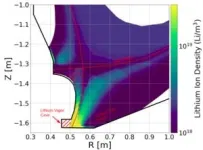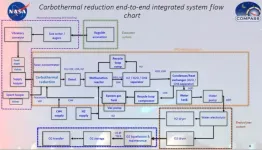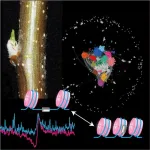(Press-News.org) Inside the next generation of fusion vessels known as spherical tokamaks, scientists at the U.S. Department of Energy’s Princeton Plasma Physics Laboratory (PPPL) envisioned a hot region with flowing liquid metal that is reminiscent of a subterranean cave. Researchers say evaporating liquid metal could protect the inside of the tokamak from the intense heat of the plasma. It’s an idea that dates back several decades and is tied to one of the Lab’s strengths: working with liquid metals.
“PPPL’s expertise in using liquid metals, particularly liquid lithium, for enhanced fusion performance is helping refine ideas about how it can best be deployed inside a tokamak,” said Rajesh Maingi, PPPL’s head of tokamak experimental science and co-author of a new paper in Nuclear Fusion detailing the lithium vapor cave.
Recently, researchers have been running computer simulations to find the best place for a lithium vapor “cave” inside the fusion vessel. To achieve commercial fusion, every part of the doughnut-shaped tokamak needs to be precisely placed. The idea behind a lithium vapor cave is to keep the lithium in the boundary layer away from the hot, fusing core plasma but near the excess heat. An evaporator — a heated surface to boil off lithium atoms — sets the lithium vapor particles off on the ideal course to where the bulk of the excess heat tends to accumulate. The scientists considered three choices in terms of cave placement. The lithium vapor cave could be located at the bottom of the tokamak near the center stack, in an area known as the private flux region; it could be in the outer edge, which is known as the common flux region; or the lithium vapor could come from both regions.
Now, results from multiple computer simulations have determined the best location for the lithium vapor cave is near the bottom of the tokamak by the center stack. The new simulations reflect additional information: They are the first to consider collisions between neutral particles, which have neither a net positive or negative charge.
“The lithium evaporator really does not work unless it is placed in the private flux region,” said Eric Emdee, an associate research physicist at PPPL and lead author of the new paper. When the lithium is evaporated in the private flux region, the particles become positively charged ions in a region with a lot of excess heat, protecting the nearby walls. Once the lithium particles are ionized, they obey the same magnetic fields as the plasma, spreading and dissipating the heat so it strikes a larger area of the tokamak and reduces the risk of components melting.
The private flux region is also the ideal target for the evaporated lithium because it is separate from the core plasma, which needs to stay hot. “You don't want your core plasma to get dirty with lithium and cool, but you also want the lithium to do some heat mitigation before it leaves the cave,” he said.
Holding the lithium: box versus cave
The researchers originally thought the lithium would be best housed in a “metal box” with an opening at the top. The plasma would flow into the gap so the lithium could dissipate the heat of the plasma before reaching the metal walls. Now, the researchers say a cave — geometrically just the inner half of a box — full of lithium vapor would be simpler than a box. The difference is more than just semantics: It impacts where the lithium travels and how effectively it dissipates heat.
“For years, we thought we needed a full, four-sided box, but now we know we can make something much simpler,” said Emdee. Data from new simulations pointed them in a different direction when the research team realized they could contain the lithium just as well if they cut their box in half. “Now we call it the cave,” Emdee said.
In the cave configuration, the device would have walls on the top, bottom and side closest to the center of the tokamak. This optimizes the path for the evaporating lithium, setting it on a better course for capturing the most heat from the private flux region while minimizing the complexity of the device.
Considering a capillary porous system to draw up the lithium
Yet another approach proposed by PPPL scientists in the new paper could achieve the same heat-quenching effect without drastically modifying the tokamak’s wall shape. In this approach, liquid lithium flows quickly under a porous, plasma-facing wall. This wall would be located where the excess heat impacts the tokamak the most: at the divertor. The porous wall allows the lithium to penetrate the surface directly facing the plasma heating, so liquid lithium is delivered exactly where it is needed most: at the area of the highest heat intensity. This capillary porous system is explained in an earlier paper published in the journal Physics of Plasmas.
The lead author of that paper, PPPL Principal Engineering Analyst Andrei Khodak, said he prefers the idea of using a porous plasma-facing wall on its own, as tiles embedded in the tokamak. “The advantage of the porous plasma-facing wall is that you don’t need to change the shape of the confinement vessel. You can just change the tile,” Khodak said. Khodak was also a co-author on the new paper, along with former Lab Director Robert Goldston.
Having lithium evaporation on the divertor surface leads to strong coupling between the plasma edge and the plasma-facing component in terms of heat and mass transfer because the heating from plasma will lead to lithium evaporation, which will, in turn, change the plasma heat flux to the liquid lithium plasma-facing component. A new model, described in a paper by the same authors in IEEE Transactions on Plasma Science, accounts for this strong two-way coupling. PPPL scientists and engineers will continue to test and develop their ideas as part of their core mission of making fusion an important part of the power grid.
The DOE supported work on the new Nuclear Fusion paper under contract number DE-AC02-09CH11466. The Physics of Plasmas manuscript was based upon work supported by the DOE, Office of Science, Office of Fusion Energy Sciences and was authored by Princeton University under contract number DE-AC02–09CH11466.
PPPL is mastering the art of using plasma — the fourth state of matter — to solve some of the world's toughest science and technology challenges. Nestled on Princeton University’s Forrestal Campus in Plainsboro, New Jersey, our research ignites innovation in a range of applications including fusion energy, nanoscale fabrication, quantum materials and devices, and sustainability science. The University manages the Laboratory for the U.S. Department of Energy’s Office of Science, which is the nation’s single largest supporter of basic research in the physical sciences. Feel the heat at https://energy.gov/science and https://www.pppl.gov.
END
Quenching the intense heat of a fusion plasma may require a well-placed liquid metal evaporator
Researchers believe they have found the ideal spot for liquid lithium in tokamaks
2024-08-21
ELSE PRESS RELEASES FROM THIS DATE:
The power of face time: Insights from zebra finch courtship
2024-08-21
A new study on songbirds sheds light on the power of social interaction to facilitate learning, insights that potentially apply to human development.
McGill University researchers discovered that zebra finches deprived of early social experiences could still form strong bonds with a partner later in life. Once placed into cohabitation with a male, females that had never heard a mating song before could quickly develop a preference for his melody.
The findings, published in Proceedings of the Royal Society ...
Near-term NASA Mars and lunar in situ propellant production: complexity versus simplicity
2024-08-21
First, lunar ISPP is analyzed from aspects of lunar resources, near-term lunar processes, carbothermal process, polar ice, and reduction of iron oxides. There are basically 4 potential lunar resources: (1) Silicates in regolith containing typically >40% oxygen. (2) Regolith containing FeO for hydrogen reduction. FeO content may vary from 5% to 14%, leading to recoverable oxygen content in the 1 to 3% range. (3) Imbedded atoms in regolith from solar wind (typically parts per million). (4) Water ice in regolith pores in permanently shadowed craters near the poles (unknown percentage but ...
An active multi-beam antenna design method and its application for the future 6G satellite network
2024-08-21
First, the payload requirements and problems faced by traditional multi-beam antenna are described. The user beam of the VHTS payload system mainly uses Ka-band multi-beam antenna for a large range of area coverage, and the number of beams in the coverage area is not less than 500, usually using 7-color frequency reuse scheme(Fig. 2). At present, the spaceborne multi-beam antenna technology applied to high-throughput communication satellites is usually divided into multi-aperture multi-beam antenna and passive multi-feed ...
EMBARGOED NEJM Catalyst TOC, August 21, 2024
2024-08-21
Contact NEJM Group Media Relations (mediarelations@nejm.org) if you’d like to receive full-text articles and author contact information for the articles listed below.
Embargoed Until 9 AM ET on Wednesday, August 21
The African American Transplant Access Program: Mitigating Disparities in Solid Organ Transplantation
D. Simpson
The Journey to an Incentive-Based Health Equity Quality Index (Embargo lifted August 14)
E. Cheng
A Physician-Created Platform to Speed Clinical Decision-Making and Referral Workflow
E. Cunningham
How a Robust Community ...
Endocrine Society honors endocrinology field’s leaders with 2025 Laureate Awards
2024-08-21
WASHINGTON—The Endocrine Society today announced it has chosen 14 leading endocrinologists as winners of its prestigious 2025 Laureate Awards, the top honors in the field.
Endocrinologists are scientists and medical doctors who specialize in unraveling the mysteries of hormone disorders to care for patients and cure diseases. These professionals have achieved breakthroughs in scientific discoveries and clinical care benefiting people with hundreds of conditions, including diabetes, thyroid disorders, ...
FAU engineering to lead $1.3 million collaborative conservation project
2024-08-21
The United States National Science Foundation (NSF) and the Paul G. Allen Family Foundation have announced a $1.3 million collaborative grant to the College of Engineering and Computer Science at Florida Atlantic University, Mote Marine Laboratory & Aquarium, and Old Dominion University, for a project designed to cost-effectively identify and track wildlife using artificial intelligence.
Xingquan “Hill” Zhu, Ph.D., principal investigator and a professor in the FAU Department of Electrical Engineering and Computer Science, is spearheading the project in collaboration with FAU’s Harbor Branch Oceanographic Institute and Charles ...
Abbott and the American Diabetes Association collaborate to drive a better understanding of the role of nutrition formulas to support people with diabetes and obesity
2024-08-21
Individuals with diabetes and obesity may have nutritional deficiencies that go undiagnosed and untreated, which can impact overall health
Providing health care professionals with nutrition tools is key to supporting patient care
Abbott’s grant to the American Diabetes Association will fund evidence generation on the nutritional needs and impact of nutrition formulas on people with diabetes and those living with obesity
ARLINGTON, Va. and ABBOTT, Ill., August 20, 2024 — The American Diabetes Association® (ADA) and Abbott recently announced a collaboration to better understand the nutritional needs of people ...
Study assesses seizure risk from stimulating thalamus
2024-08-21
The idea of electrically stimulating a brain region called the central thalamus has gained traction among researchers and clinicians because it can help arouse subjects from unconscious states induced by traumatic brain injury or anesthesia, and can boost cognition and performance in awake animals. But the method, called CT-DBS, can have a side effect: seizures. A new study by researchers at MIT and Massachusetts General Hospital (MGH) who were testing the method in awake mice, quantifies the probability of seizures at different stimulation currents and cautions that they sometimes occurred even at low ...
Machine learning approach towards quality assurance, challenges and possible strategies in laboratory medicine
2024-08-21
The integration of machine learning (ML) and automation in laboratory medicine marks a significant advancement, revolutionizing diagnostic accuracy and operational efficiency. This review examines the impact of these technologies, highlighting both their potential benefits and the challenges they pose. The advent of automation combined with ML has introduced new capabilities in pattern detection, predictive analytics, and sophisticated data handling, which are crucial for navigating the complexities of biomedical data. However, these advancements also bring concerns regarding data privacy, the need for stringent validation procedures, and the integration of new technologies into existing ...
Survival tactics: AI-driven insights into chromatin changes for winter dormancy in axillary buds
2024-08-21
Evolution has enabled plants to survive under adverse conditions. The winter bud of a plant is a crucial structure that establishes adaptability. Depending on environmental and intrinsic conditions, buds can transition between growth and dormancy. The three dormancy phases are determined by signals triggering each phase: ecodormancy, influenced by environmental factors; paradormancy, promoted by other plant organs; and endodormancy, maintained by internal signals within the bud. Paradormant buds enter endodormancy in response to changes in day length and/or low temperature in autumn, while endo-and eco-dormant phases occur ...
LAST 30 PRESS RELEASES:
Anthropologists offer new evidence of bipedalism in long-debated fossil discovery
Safer receipt paper from wood
Dosage-sensitive genes suggest no whole-genome duplications in ancestral angiosperm
First ancient human herpesvirus genomes document their deep history with humans
Why Some Bacteria Survive Antibiotics and How to Stop Them - New study reveals that bacteria can survive antibiotic treatment through two fundamentally different “shutdown modes”
UCLA study links scar healing to dangerous placenta condition
CHANGE-seq-BE finds off-target changes in the genome from base editors
The Journal of Nuclear Medicine Ahead-of-Print Tip Sheet: January 2, 2026
Delayed or absent first dose of measles, mumps, and rubella vaccination
Trends in US preterm birth rates by household income and race and ethnicity
Study identifies potential biomarker linked to progression and brain inflammation in multiple sclerosis
Many mothers in Norway do not show up for postnatal check-ups
Researchers want to find out why quick clay is so unstable
Superradiant spins show teamwork at the quantum scale
Cleveland Clinic Research links tumor bacteria to immunotherapy resistance in head and neck cancer
First Editorial of 2026: Resisting AI slop
Joint ground- and space-based observations reveal Saturn-mass rogue planet
Inheritable genetic variant offers protection against blood cancer risk and progression
Pigs settled Pacific islands alongside early human voyagers
A Coral reef’s daily pulse reshapes microbes in surrounding waters
EAST Tokamak experiments exceed plasma density limit, offering new approach to fusion ignition
Groundbreaking discovery reveals Africa’s oldest cremation pyre and complex ritual practices
First breathing ‘lung-on-chip’ developed using genetically identical cells
How people moved pigs across the Pacific
Interaction of climate change and human activity and its impact on plant diversity in Qinghai-Tibet plateau
From addressing uncertainty to national strategy: an interpretation of Professor Lim Siong Guan’s views
Clinical trials on AI language model use in digestive healthcare
Scientists improve robotic visual–inertial trajectory localization accuracy using cross-modal interaction and selection techniques
Correlation between cancer cachexia and immune-related adverse events in HCC
Human adipose tissue: a new source for functional organoids
[Press-News.org] Quenching the intense heat of a fusion plasma may require a well-placed liquid metal evaporatorResearchers believe they have found the ideal spot for liquid lithium in tokamaks








